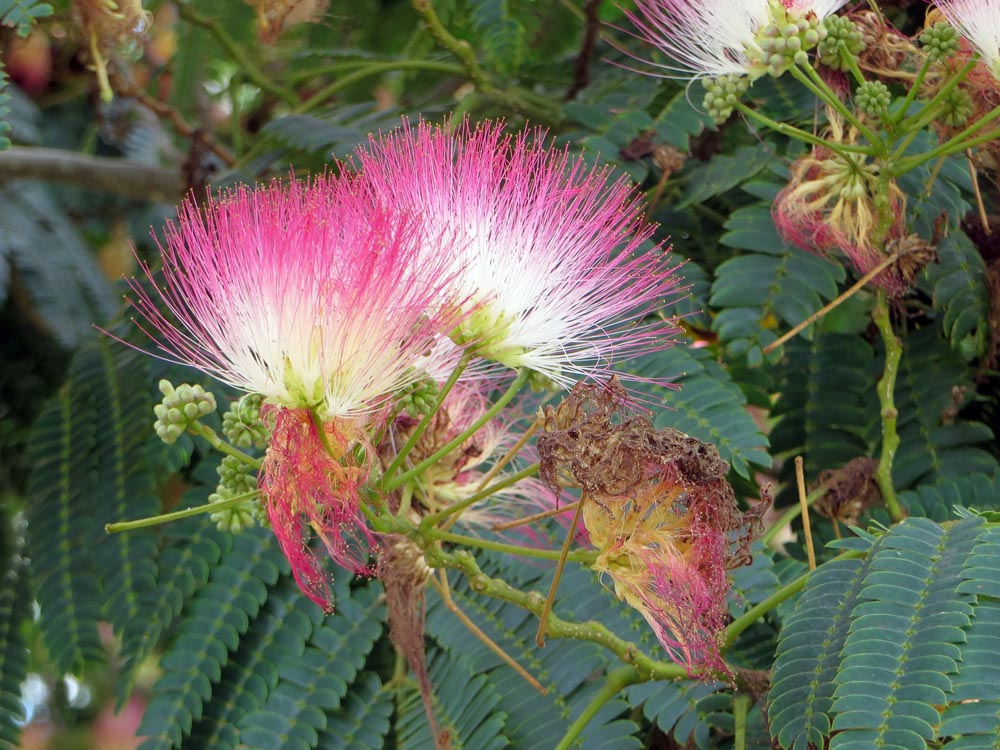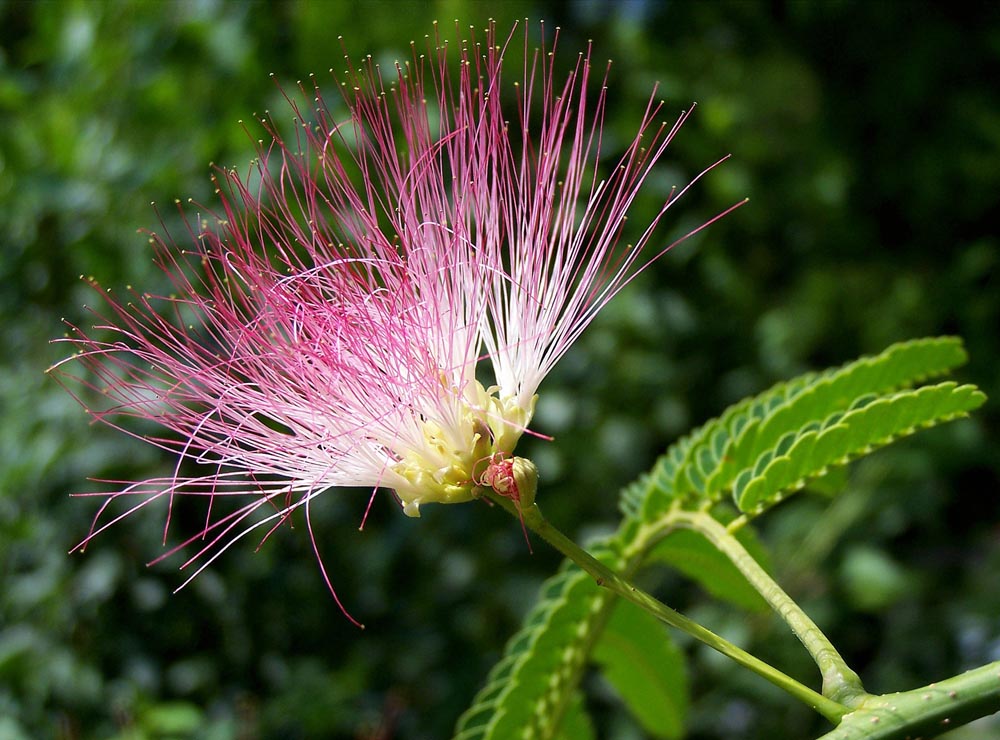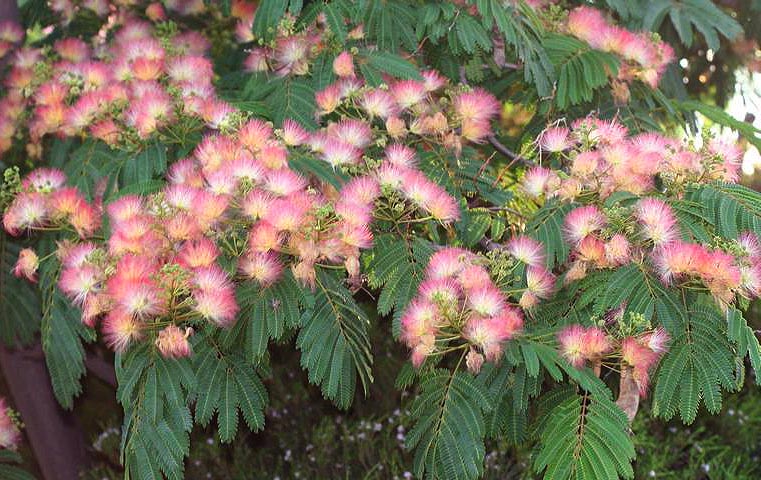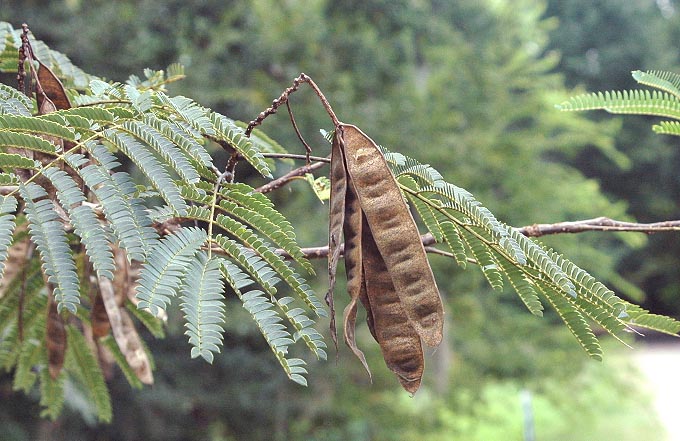An exotic tropical looking tree that grows in cooler zones. This fairly small tree while it can grow to 40 feet (12 m) in cooler zones 6-7 and in some cases 5 usually does not reach more than about 25 feet (6.2 m). It is a fairly short lived tree lasting only about 15-20 years but its beautifully exotic powder puff flowers that are produced in such profusion over the summer months make up for any downfalls. It has a wide spreading habit with open airy branches that allow dappled shade beneath and being a nitrogen fixer it will provide food for any plants grown beneath it. It loves sunshine and heat and given its own space will make a dazzling display.
In warmer southern zones it will grow much faster and will need some control to keep it in check.
Its not fussy about soil type and will grow anywhere that is not water logged. Needs little water and is fairly drought tolerant needing little care once established, other than leaf and seed pod cleanup in the fall.
For many this tree is grown mostly for its medicinal properties. First in China, where it has been used for centuries and now in the US herbal community its known as 'the happiness tree' since it is used to treat depression, anxiety and grief.
The leaves are delicate and fern like. They are dark green in color and each leaf compound and can be as long as 20 inches (50.8 cm). A thickish central stem holds many sub-leaves known as pinnae that are arranged in pairs along the central stem with two long ones in a Y shape at the end of the leaf and pairs of long pinnae behind this pointing forwards. These can be up to 4 inches (10 cm) long but reduce in length towards the base of the leaf. A leaf commonly consists of 6-8 pairs but larger trees can have as many as 20 pairs. Each one of these Pinnae also has opposite pairs of leaflets, the true 'business' part of the leaf. Each leaflet is about 0.5-1.5 inches (1.27-3.8 cm long and 0.5 inches (1.2 cm) wide with about 1--20 leaflets to each pinnae. This gives the leaf a airy fern like or feathery appearance. This structure gives the leaves much more flexibility and leaflets will fold up at night or during heavy rains to protect themselves and allow rain to penetrate to ground level.
The flowers begin to appear in late spring into summer and can last for 2 months with a constant succession of flower heads. Flowers are borne in terminal clusters at the base of the current year's twigs. Flowers resemble fluffy pom poms that are around 2 inches ( cm) across and consist of 15-25 small flowers packed tightly together. Each flower a green base, a combination of the calyx and corola, that encircles a tubular shaped stamen tube. This tube is white at the base but then splits into about 20 slender stamen tendrils that are pink lighter and darken in color towards the end. At the tip is a circle of yellow pollen. The stamens encircle a single stigma in the center of each flower. There are no petals on these flowers just fluffy looking stamens that are each about 1.5 inches (3.8 cm) long and highly aromatic. Flowers begin bright pink but darken with age and curl over. Each flower cluster is short lived but the trees produce multitudes of them so flowering continues for several months. Trees can have developing seed pods and still be flowering strongly.
The fluffy seed heads and the fine ferny foliage give the trees a more tropical appearance which is often highly desired in northern latitudes.
Seed pods are long anywhere from 4-10 inches (10-25.4 cm) and about 1 inch (2.5cm) wide and pointed at each end. The pods are flat but indented similar to a section of bubble wrap with each 'bubble' being a potential seed. Most pods however do not contain a full compliment of seeds even though the indentations for them are there and they are much larger than the seeds they contain. Seeds are usually darker brown, flattened ovals about 0.5 inches (1.27 cm) long. Pods can remain on the tree until late in the winter months or even persist until spring. Leaves also tend to remain green and stay on the plant until the frost kills them and they fall.
After soaking check to see if the seeds have swollen as they absorb the water. Those that have are ready to plant any that have not are being stubborn and need more treatment. They can either be re-soaked or they can be scarified first to help reduce the tough coating.
Many sources suggest nicking the seed with a knife or other sharp object. We feel this is a sure method to damage yourself and soak the seeds in blood which does not really help germination.
The safest and surest method we have come up with is Sandpaper. For this you will a sheet of rough or course sandpaper and a course sanding sponge. the coarsest you can get. Put the sheet on a firm flat surface and place some seeds on it. Not more 8-10 or it gets too hard to handle. If you have more seeds to them in batches. Use the sanding sponge and firmly drag the seeds across the surface of the sandpaper sheet. This method may require several intense rubbing sessions to get the seeds well scratched but we have found it faster and far safer on the fingers than any other method.
Once seeds have swelled plant in small individual pots of good well draining compost about 0.75 inches (2cm) deep. Place in a warm location in good light and keep soil moist but not wet until the seeds sprout. This can take anywhere from a week to several months depending on the seeds and location.
Grow seeds on and repot once they get larger, keep repotting to larger pots as the tree grows and plant out when they have reached no less than 12 inches (30.5 cm) in height. Surround newly planted trees with chicken wire and mulch to keep weeds and wildlife away from new plants. Keep soil moist until trees have become established and begun to grow well. For more details see our Growing Trees from Seeds article.
Best flowering occurs in full sunshine, this tree likes heat . Planting in a wide space to allow them to develop their wide structure provides a more interesting and beautiful tree.
Fully hardy to zone 6 but will need protection in zone 5 planting in a courtyard near a house or other protective structure may be needed.
In the southern states this tree can grow and develop rapidly care should be taken it keep growth in check by pruning.
Due to its spreading habit more sunlight reaches the ground than with other trees. In addition this tree is a nitrogen fixer so it increases ground fertility allowing other plants to be grown beneath it benefiting from the tree.
However others state that the branches of this tree are never that large since it never becomes are really large tree so any branch that does fall would cause minimal problems. This school of thought recommends the tree be grown close to a home overshadowing a patio as the wide spreading nature of the tree offers good dappled shade so the outdoors can be enjoyed in relative coolness enjoyed by its wide branches while enjoying watching the humming birds and butterflies in the flowers. Because this tree folds up its leaves at night this allows any hot air trapped on the patio to escape leaving cooler air in its place for the next day. Additionally since the tree tends to hold its leaves until first frost then drop them all at once cleanup is just one task rather than a continuous one. While some state that the falling leaves and seed pods pose a cleanup problem they seem no different or time consuming that any large trees that drop leaves in winter.
On the downside there are also a lot of other insects that have found this a wonderful food source and ate the leaves, seeds and flowers. Some are good such as several species of butterfly the Reakirk's Blue (Hemiargus isola) being a common one. But there are also scale, webworms and seed beetles that have found this a good source of food. Other problems include Mimosa webworms, mites, Vascular Wilt Disease, Shot Hole Borer, Armillaria Fungus, Root Rot, and a cottony cushion scale. In southern states a infections fungi (Fusarium wilt) is widespread and can kill large trees
Deer and other wildlife however don't seem to eat it.
In more northern states this is not such a problem as the trees don't seem to self seed and grow with such vigor while one or possibly two trees may be seen occasionally the cool winters seem to keep them in check. Here the exotic tropical look of the trees and the beauty of the flowers may far outweigh the slight possibility of spreading. This however may change as global warming creeps up the country allowing the trees to survive and reseed in what were cooler zones.
The flowers are carminative, and used as a sedative and to treat insomnia, irritability, breathlessness and poor memory as well as digestive issues and intestinal worms.
The bark has similar properties and a tincture is used to treat insomnia and irritability. Externally it is used as a wash or a poultice to treat boils, carbuncles, swelling and injuries.









